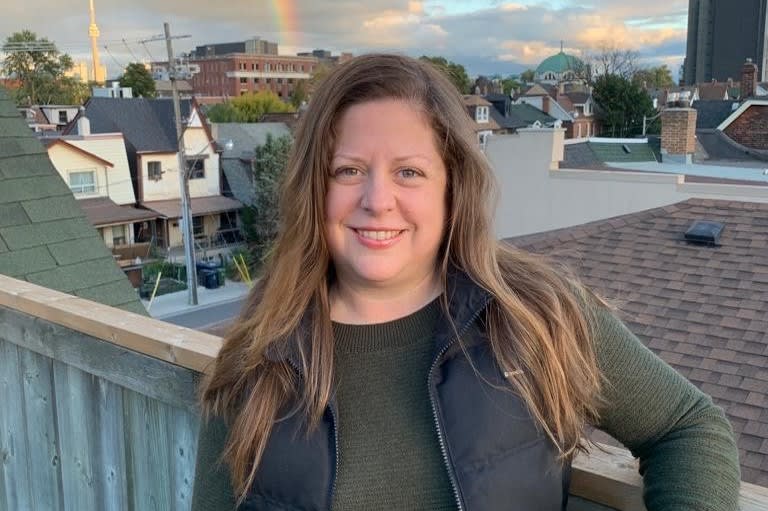Cynthia Bettio honoured with Esri Canada’s Making a Difference Award
High school teacher from Ontario connects classrooms to communities using modern geographic information system (GIS) technology.

Cynthia Bettio, recipient of the Esri Canada Making a Difference Award
Students remember impactful teachers long after graduation day, and often, it’s the teachers who stand out for their ability to bridge the gap between the classroom and the real world. Cynthia Bettio—head of Canadian and World studies, English, and Arts at St. Katharine Drexel Catholic High School in Stouffville, Ontario—does just that. Esri Canada recognized Ms. Bettio with a Making a Difference award, which spotlights individuals and organizations using geographic information system (GIS) technology to make a positive impact on their communities.
By incorporating Esri’s cloud-based mapping and analysis software, ArcGIS Online, into her geography and history classes, Ms. Bettio transforms abstract subjects into dynamic, hands-on learning experiences. She engages students with projects that integrate real-world data and local history, encouraging them to think critically, tackle complex problems and make meaningful connections between their coursework and the world around them. Plus, students get the satisfaction of knowing that with a little practice and instruction, they can master the same professional tools employed by city planners.
“If we want kids to care about the subjects they’re learning, we have to show them where they can connect to these subjects,” says Ms. Bettio. “They need to see their community in what they’re learning.”
With that approach in mind, Bettio spearheaded a partnership between her school and the Town of Whitchurch-Stouffville. Students in her Grade 9 Geography class used ArcGIS Online to map and design three areas hypothetically marked for development near the school, learning how urban planning intersects with environmental sustainability and community needs. Since much of the town is on protected land, the project asked students to address a concrete challenge facing their growing home community: finding creative ways to use what little space is available for development.
Using professional-grade tools in the classroom has had a transformative effect on the learning process, building students' confidence as they apply practical skills and present their ideas to elected officials. It’s all part of Ms. Bettio’s unconventional teaching philosophy, which consistently moves beyond traditional textbook teaching and brings subjects to life by grounding them in practical, community-driven projects.
Ms. Bettio first encountered ArcGIS Online in 2016 at the Esri Canada User Conference, where she saw firsthand the software’s flexibility and potential for use in the classroom. Inspired by what she learned, she quickly began incorporating ArcGIS Online into her teaching. Since then, she’s used it to create interdisciplinary projects that allow students to dive deeply into local history and geography.
“If we focus on local issues that are relevant to students’ lives, we can ask them to step back and examine the bigger picture with greater depth and understanding,” notes Ms. Bettio.
Another standout project involved her Grade 10 Advanced Placement Canadian History class at her previous school. Students explored the microhistory of Richmond Hill by researching specific lots in the city, tracking changes from 1914 to 2023. Collaborating with the local history librarian, students accessed primary documents and data from the Richmond Hill Public Library’s Local History Room. They then used ArcGIS StoryMaps to present their findings, visually documenting the evolution of their assigned lots.
This project didn’t just meet the curriculum’s requirements—it exceeded them. In June 2023, the students presented their research to the Richmond Hill Historical Association, and their work will be housed on the library’s website as a testament to the depth of their findings.
“Cynthia is an outstanding community builder,” says Alex Miller, president of Esri Canada. “She connects her students with their community and empowers them with GIS skills and tools to solve real-world problems that impact them. Cynthia is nurturing mapping minds among the youth, which is helping shape a better world.”
With each new initiative, Bettio showcases the power of GIS technology in education, proving that with the right support, students can navigate professional-level tools and tackle substantial challenges. Her teaching helps students gain a deeper understanding of how functional communities are designed—all while equipping them with practical skills used by professionals.
“Innovation in the classroom isn’t just about technology; it’s about pushing ourselves to think differently,” Ms. Bettio reflects. “When we do that, we open up new possibilities for our students—and for the future they’ll help create.”
Watch this video: Teaching with ArcGIS: Engaging students in community development